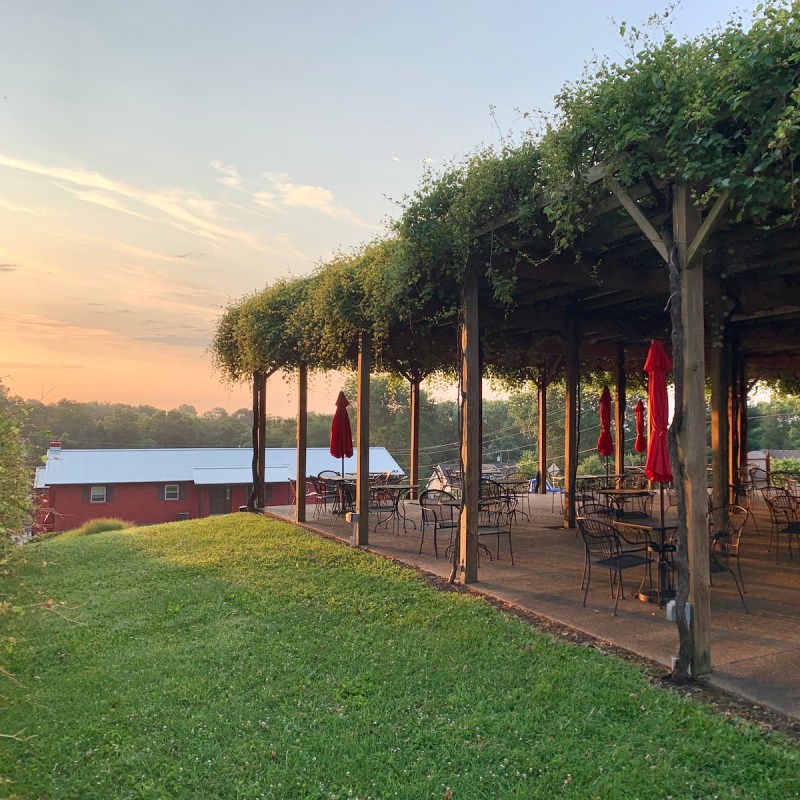
The charming hamlet of Augusta, Missouri, has long been a beloved destination for visitors from throughout the Midwest. Its historic homes, sweet shops, and stunning scenery, plus close proximity to the Katy Trail, have made it a road-trip favorite.
Videos by TravelAwaits
The town also has deep history when it comes to American winemaking. Germans who first settled in the area 150 years ago quickly planted grapes and made wine, a tradition that’s continued for generations.
But changes are on the way. Recently, a Florida-based developer with its own Missouri roots announced a sweeping new vision for Augusta. The Hoffmann Family of Companies is acquiring wineries, shops, and other properties, then renovating and transforming them. The goal: to make Augusta a nationally-renowned destination for wine lovers. Here’s a look at what might be next for the area.

Where Is Augusta, Missouri?
Located in St. Charles County, about an hour west of St. Louis, Augusta is perched on the limestone bluffs near the Missouri River. It’s close to the city but maintains a quiet, laid-back, and small-town vibe — until the weekend, when crowds pack the tiny town for wine tastings, antiquing outings, and overnight stays.
Augusta was founded by German immigrants who flocked to the region west of St. Louis starting in the 1830s. They settled there specifically because the Missouri River reminded them of the Rhine Valley they had left behind. In short, it felt like home sweet home, and they stuck around to establish farms, homes, and the community.

History Of Wine Making In The Area
It turns out the soil of the Missouri River Valley was also conducive to grape growth, just as the Rhine Valley was. The Germans quickly planted vines, and well-established family wineries cropped up in Augusta and in nearby Hermann.
While Missouri wineries flourished, their impact was also felt globally. In the 1860s, as tiny lice called phylloxera ravaged French vineyards, Missouri state entomologist Charles Riley discovered that the bugs only ate the leaves of Missouri vines and not the roots. The state’s grapes were resistant to the worst of the scourge. Cuttings were sent to be grafted onto the legendary French vines, saving the industry there.
Prohibition took its toll on Missouri’s wine traditions, and Augusta wasn’t spared. Vines were uprooted and left to die, wine barrels were dumped, and the village’s cellars lay dormant. A renaissance began in the 1960s when many of the current wineries were founded or resumed production after a long hiatus.
In 1980, Augusta was named the nation’s first American Viticultural Area, or AVA, a designation given to wine grape-growing regions distinguishable by geographic features.

Augusta’s Makeover In Progress
Enter real estate developers David and Jerri Hoffmann. The couple grew up just across the Missouri River in Washington, Missouri, and knew Augusta well. Several years ago, they noticed changes that could be made and decided to act.
“During a trip to the area in 2020, they saw the town and area was in need of improvement to bring back its charm,” said Chris Armstrong, CMO of Hoffmann Family of Companies. “There is a grand vision for the area that is ever expanding with the goal of putting Augusta, Missouri on the map as an international wine destination.”
The Hoffmanns brought not only a grand vision but an established track record. They’ve launched successful restoration projects in Avon, Colorado; Naples, Florida; and Winnetka, Illinois, and quickly got to work in Augusta with an epic $100 million spending spree. To date, they’ve purchased four wineries, 1,500 acres of vineyards, and more than a dozen buildings in downtown Augusta and the nearby area. Maintenance on many is complete, and businesses are opening at a rapid pace.

“Plans are to open a new business or entity every 90 days or so for the foreseeable future,” said Armstrong.
A general store and clothing boutique now welcome customers, and there are new dining options in town. Weekenders can stay at refurbished guest cottages, and a luxe yacht — the Miss Augusta — currently cruises the Missouri River between nearby Klondike Park and Mount Pleasant Winery in Augusta.
A 12-hole championship golf course and a luxury hotel/spa are also in the works.
The Hoffmanns aren’t at all bashful about their aspirations for Augusta. Their website states the goal for the town and surrounding region is “ to create a world class destination much like that of Napa Valley and Sonoma.”

Why Is The Area Being Compared To Napa?
Missouri is half a country from California’s famed Napa Valley, and hundreds of millions of gallons away from its annual wine yield, but the Hoffmanns remain bullish about Augusta in particular.
For starters, the Missouri River Valley set the stage for Napa, as one of the country’s top wine producers in the 1880s. It’s often compared to Napa because indeed, it was the valley’s precursor.
And then there’s the matter of climate change. While its effects have been devastating for California wine country, causing massive wildfire outbreaks and drought, warming weather might actually mean Missouri could support new types of grapes. That could be a win for the region, as it’s typically seen as producing sweeter wines than its California counterpart.
Those distinctions aside, Armstrong says Missouri’s vinos already have the power to punch above their weight class.
“Missouri wine is very underrated,” he said. “There are phenomenal wines, many award winning, that come out of Missouri that I feel would hold to up or beat many of the wines out of other regions.”

Tips For Visiting
Augusta’s an easy day or weekend trip from St. Louis. Be sure to pack your patience though, as traffic can jam the small, winding state highway you’ll take to reach town.
If you’re going to sip and sample Augusta’s wines, consider staying overnight to really get a feel for the small town’s atmosphere. It’s entirely walkable, so you won’t have to worry about getting behind the wheel. If you’re determined to make it a day trip, designate a driver or hire a charter service to ensure you make it home safely.
Related Reading:

